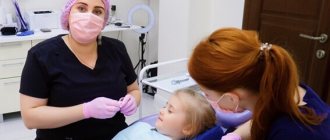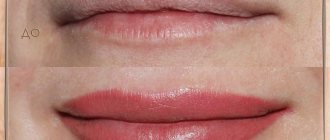Surgeon (children)
Goltsova
Evgenia Vyacheslavovna
14 years of experience
Surgeon (children)
Make an appointment
A congenital malformation of the maxillary region of the face has the appearance of a cleft lip. In medicine, this phenomenon is called cheiloschisis, and popularly – “cleft lip”. Sometimes the pathology can be large. About 0.04% of babies are born with it. The cause is a mutation in the TBX22 gene. In rare cases, it may be combined with another defect called “cleft lip”. This happens in 1 case in 2500 babies. It is recommended not to delay in correcting the defect. Otherwise, problems arise with the child’s nutrition and speech development. The congenital defect does not affect intellectual development. It has aesthetic significance and affects the psychological and emotional state.
What are the hidden reasons for the birth of children with an aesthetic lip defect?
With the cleft lip defect, the causes must be sought at the genetic level. The tissues of the maxillofacial region are laid down and formed during the period of intrauterine development up to 8 weeks. If a woman was influenced by certain negative factors during pregnancy, this also affects the fetus. There may be the following reasons for the formation of pathology:
- the age of the mother and father exceeding 40 years;
- genetic predisposition;
- poor environmental conditions;
- bad habits (smoking, drugs, alcohol);
- severe vitamin deficiency during pregnancy;
- history of infectious diseases;
- fetal hypoxia in early pregnancy.
It is difficult to determine the exact reasons. Geneticists continue research in this area. It is known that several genes can fail at once. In subsequent generations, the risk of having a child with a cleft lip defect is equal to 7%. With chromosomal abnormalities, not only cleft lip, but also a number of other syndromes may appear. There is a great risk if a pregnant woman lives in areas with chronic intoxication with the influence of such substances: mercury, benzene, lead, pesticides.
Are you experiencing cleft lip symptoms?
Only a doctor can accurately diagnose the disease. Don't delay your consultation - call
2.Cleft lip or cleft palate
Cleft lip or cleft palate, scientifically called “cheiloschisis,” is a common congenital pathology. A cleft lip is formed due to mutations in genes that “program” the maxillofacial part of the skull. A cleft lip is a cleft palate that has not healed during the child’s intrauterine development. A similar defect occurs in approximately one child in 2-3 thousand newborns. More often, cleft lip appears in boys.
The following aspects of a mother's life may contribute to the development of a cleft lip:
- Drug and substance abuse;
- Radiation exposure;
- Alcohol;
- Smoking;
- Stress;
- Injuries.
In addition, statistics note that women over 35 years of age have a much higher risk of having a child with this pathology than young mothers.
Visit our Microsurgery page
What are the forms of the disease?
In the medical classification, there are three forms of congenital pathology - complete, incomplete and hidden. The first form is a deep cleft that rises from the lip to the nose. Can be one- or two-sided. The cause of the pathology is associated with non-fusion of the nasal process with the right or left maxillary. With an incomplete form of the defect, partial splitting in the form of a one-sided depression is observed. Each case is individual, so the “cleft lip” in children can vary in length and depth. The situation is simpler if the defect affects only soft tissue. It happens that the deformation also affects the nose. In newborns, the disease “cleft lip” is expressed in the presence of pathology, but with preservation of the mucous membrane and skin in the presence of clefting.
Where to get treatment
When consulting a child with a congenital cleft in a particular medical institution, parents should receive reasoned answers to a number of questions:
- What types of surgical intervention and at what age will the child undergo?
- What determines the choice of this particular surgical treatment tactic?
- How many children with this pathology are operated on in this medical institution annually?
- How often are postoperative complications recorded (dehiscence of postoperative sutures, formation of palate defects?) What causes postoperative complications?
- What are the cosmetic results (immediate and long-term) of treatment for children, presented in the form of photographs, and how are deformities of the upper lip and nose corrected in the future?
- What are the functional results of treatment: how often does typical speech pathology – rhinolalia – and deformation of the upper jaw/occlusion develop?
- Is there a comprehensive rehabilitation system in this institution (speech therapist, orthodontist, ENT doctor, pediatrician, neurologist, pediatric anesthesiologist)? How long and how will it be carried out?
How can an aesthetic defect be eliminated?
A child diagnosed with cleft lip is treated surgically. There is no other way to eliminate the aesthetic defect. Treatment is indicated for all newborns provided there are no contraindications. Mostly cheiloplasty is performed at the age of 3 to 6 months. At a later age, it is possible to perform plastic surgery, but there is no point in procrastinating. The sooner the operation is performed, the less noticeable the consequences will be. In difficult cases, doctors carry out corrections in the first days of life. The difficulty is presented by the small anatomical structure of the lips in newborns, and imperfect physiological functions can cause blood loss during surgery.
Basic principles of treatment
Today, more than ever in the history of medicine, the high level of technology allows for complete rehabilitation of a child at an early age. Basic principles of successful treatment: performing the main stages of surgical treatment before the age of 1 year; dispensary observation for 18 years in a specialized center.
Protocols for early surgical treatment are generally accepted in many European countries, the USA and Canada. It is they, according to leading experts, that ensure the achievement of optimal cosmetic and functional results: natural and symmetrical facial contours, normal speech and physiological occlusion.
The optimal protocol for surgical treatment of patients, developed at the Institute of Congenital Diseases of the Maxillofacial Region and used since 1990 in the treatment of at least 10 thousand patients, includes the following main stages:
- Primary cheilorhinoplasty (upper lip and nose surgery) for all types of clefts of the upper lip from the age of 1 month.
- Plastic surgery of the soft palate at the age of 6-8 months.
- Plastic surgery of the hard palate at the age of 12-14 months.
- Bone grafting of the alveolar process of the upper jaw at the age of 8-12 years.
- Reconstructive surgeries (if necessary) at any age.
The goal of treating a child with a congenital cleft lip and palate is not only to eliminate the defect. Modern methods of surgical, orthodontic treatment and speech therapy training will allow your baby to have ideal facial contours, normal speech and demonstrate a beautiful and continuous dentition when smiling.
What is special about pediatric maxillofacial surgery?
The main feature of oral and maxillofacial surgery is that it is closely related to other areas of medicine. Thus, parents of a child with a cleft lip and palate should clearly understand: the operation performed is not the final stage of treatment for the disease. Everything is individual, but as a rule, after primary reconstructive surgery, corrective surgery is required, as well as treatment and rehabilitation in several stages. Repeated operations are aimed at eliminating residual defects and deformations and improving the aesthetic appearance. Most children will have to undergo long-term rehabilitation with a professional speech pathologist-speech pathologist to eliminate organic rhinolalia - a violation of the timbre of the voice towards nasality, which is a specific sign of speech in children with a cleft. All of our patients will need multi-stage, long-term care from an orthodontist to correct their dentition and bite with various orthodontic devices, and in adolescents, with braces. Ideal conditions are to receive the necessary treatment and consultations from all specialists in one place. Therefore, it is no coincidence that the parents of young patients who need the help of a maxillofacial surgeon strive to get to Moscow: there are ample opportunities to receive qualified medical care on the basis of multidisciplinary hospitals.
How is a cleft lip treated in a hospital?
For surgery to repair a cleft lip, your child is usually referred for treatment in an inpatient clinic setting. The clinic has apartments where the mother or father of the child can stay. The child can have constant contact with the parents; in addition, if necessary, the sisters can call the parents at night. In some departments, one of the parents may be with the child.
On the day of your inpatient placement, you must register before 10:00 a.m. at the department. After this, a group of specialists will receive you. At about 1:30 p.m., you accompany your child to an appointment at the clinic and clinic for maxillofacial and oral surgery to obtain consent for the operation, where any questions you may have regarding the operation can be resolved. The anesthesiologist also takes part in the appointment in order to inform you in detail about anesthesia. You should remain in the department until you have spoken with all doctors and signed an informed consent for the operation and anesthesia. In this way, you can help avoid delays in the operation.
To confirm the success of the treatment, we take photographs and videos to assess muscle function. This usually occurs during a cleft treatment appointment. In cases where this is not possible, we can organize these events either on the day How is cleft lip treated in a clinic setting, or on a separate day, by agreement with you.
You can get clothes for your baby and a stroller at the department. You should take clothes for older children from home. Think about what toys you can bring from home to provide distractions for your child, as well as reading materials for yourself. All necessary food products for the child are available in the department. If a child needs special nutrition, this should be discussed before admission to the hospital.
As a rule, operations are performed one day after hospitalization. Before the operation begins, you can accompany your child to the operating room, but you must not be in the operating room during the administration of anesthesia and during the operation. The surgeon performing the operation will discuss the progress of the operation and the achieved result with you immediately after the operation is completed. To do this, you must obtain prior consent.
During surgery to repair a cleft lip or palate, we try to avoid using a gastric tube to feed the child. In some cases, the use of a tube makes sense to facilitate the child’s feeding immediately after surgery. Experienced nurses will provide you with practical assistance and give you the necessary advice. Of course, during your hospital stay, it is possible to pump out the mother's milk if you want to continue feeding the baby. In order not to impede the healing of the wound after the connection of the cleft lip and the soft and hard palate. Your baby should be fed only liquid foods at first. The pacifier should be discarded. To ensure normal feeding, it would be useful to start feeding the child with a spoon before the operation.
The child's total stay in the hospital is usually 8-10 days. During the child's stay in the children's clinic, he receives daily medical care and examination by a doctor from the clinic of maxillofacial and oral surgery.
Types of cheiloplasty
Bulhorn lip surgery is aimed at reducing the distance between the base of the nose and the border of the upper lip.
Allows you to harmonize facial features in general, and emphasizes shape and volume
It is performed under local anesthesia with sedation. The duration of the operation is 30-40 minutes. Sutures are removed 10 days after surgery.
Kesselring lip surgery is aimed at adding volume to the lips by excision of the upper border of the lips.
Allows you to achieve plump lips with a stable result.
It is performed under local anesthesia with sedation. The duration of the operation is 50-60 minutes, depending on the volume. Stitches are removed after 8-10 days
Lip surgery “Dao resection” - aimed at correcting drooping corners of the lips using resection
a certain part of the muscles of the corners of the mouth. The duration of the operation is 30 minutes.
The operation is performed under local sedation. Stitches may not be removed.
Corner Lift lip surgery is an operation aimed at lifting the corners of the lips by excision of a portion of the skin flap in the corners of the lips. The duration of the operation is 30-40 minutes. The sutures are removed on days 7-9.
VY lip plastic surgery is aimed at correcting the volume of the lips due to the lip mucosa. It is performed under local anesthesia with sedation. The stitches are removed after 8-10 days. The operation allows you to increase the volume of your lips without resorting to correction with fillers. Duration of the operation is 40-60 minutes











